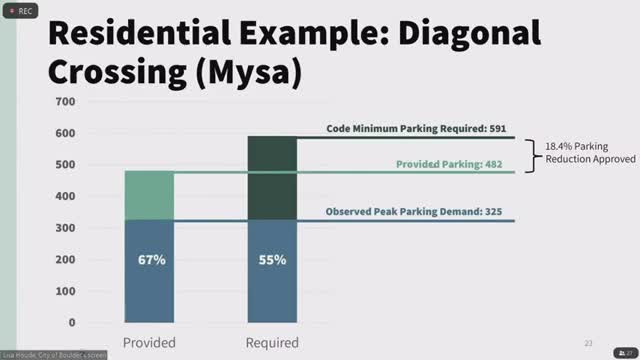City explores radical parking requirement overhaul
August 09, 2024 | Boulder, Boulder County, Colorado
This article was created by AI summarizing key points discussed. AI makes mistakes, so for full details and context, please refer to the video of the full meeting. Please report any errors so we can fix them. Report an error »

In a recent government meeting, city officials discussed significant findings regarding parking requirements and transportation demand management (TDM) strategies aimed at optimizing urban development.
Data presented revealed that the city currently has an excess of parking spaces across various land uses, with nearly half of the available parking going unused during peak demand times. Specifically, a recent analysis indicated that out of 590 approved parking spaces, only 325 were utilized at peak times, suggesting that the city is over-providing parking facilities. This trend was noted across all land uses, prompting city staff to recommend a reevaluation of existing parking requirements.
Officials proposed exploring the elimination of off-street parking requirements citywide, citing that current regulations mandate more parking than is necessary. They also suggested implementing state regulations within transit service areas and potentially extending these to other areas to avoid a complex regulatory environment.
In conjunction with parking discussions, the meeting also addressed the development of a new TDM ordinance. This ordinance aims to align with a shift towards parking maximums rather than minimums, establishing measurable targets for TDM plans. The goal is to create a framework that allows for better evaluation and enforcement of compliance, ensuring that new developments contribute positively to the city’s transportation and climate objectives.
City planners emphasized the importance of defining the purpose and desired outcomes of the TDM ordinance, weighing the balance between mitigating immediate impacts of new developments and promoting broader travel behavior changes. They also discussed the need for clear triggers and thresholds for when the ordinance would apply, considering factors such as development size and location.
As the city moves forward with these initiatives, officials are seeking input from council members and stakeholders to refine their approach and ensure that the new regulations effectively address the community's needs while promoting sustainable urban growth.
Data presented revealed that the city currently has an excess of parking spaces across various land uses, with nearly half of the available parking going unused during peak demand times. Specifically, a recent analysis indicated that out of 590 approved parking spaces, only 325 were utilized at peak times, suggesting that the city is over-providing parking facilities. This trend was noted across all land uses, prompting city staff to recommend a reevaluation of existing parking requirements.
Officials proposed exploring the elimination of off-street parking requirements citywide, citing that current regulations mandate more parking than is necessary. They also suggested implementing state regulations within transit service areas and potentially extending these to other areas to avoid a complex regulatory environment.
In conjunction with parking discussions, the meeting also addressed the development of a new TDM ordinance. This ordinance aims to align with a shift towards parking maximums rather than minimums, establishing measurable targets for TDM plans. The goal is to create a framework that allows for better evaluation and enforcement of compliance, ensuring that new developments contribute positively to the city’s transportation and climate objectives.
City planners emphasized the importance of defining the purpose and desired outcomes of the TDM ordinance, weighing the balance between mitigating immediate impacts of new developments and promoting broader travel behavior changes. They also discussed the need for clear triggers and thresholds for when the ordinance would apply, considering factors such as development size and location.
As the city moves forward with these initiatives, officials are seeking input from council members and stakeholders to refine their approach and ensure that the new regulations effectively address the community's needs while promoting sustainable urban growth.
View full meeting
This article is based on a recent meeting—watch the full video and explore the complete transcript for deeper insights into the discussion.
View full meeting
